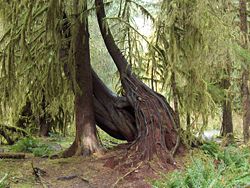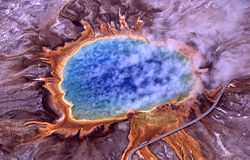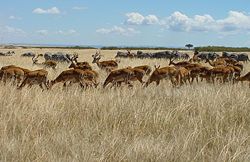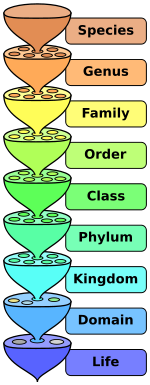Life
2008/9 Schools Wikipedia Selection. Related subjects: Biology
| Life | ||
|---|---|---|
 Life on a rocky peak in the Waitakere Ranges
|
||
| Scientific classification | ||
|
||
| Domains and Kingdoms | ||
|
Life is a condition that distinguishes organisms from non-living objects, such as non-life, and dead organisms, being manifested by growth through metabolism and reproduction. Some living things can communicate and many can adapt to their environment through changes originating internally. A physical characteristic of life is that it feeds on negative entropy. In more detail, according to physicists such as John Bernal, Erwin Schrödinger, Eugene Wigner, and John Avery, life is a member of the class of phenomena which are open or continuous systems able to decrease their internal entropy at the expense of substances or free energy taken in from the environment and subsequently rejected in a degraded form (see: entropy and life).
A diverse array of living organisms can be found in the biosphere on Earth. Properties common to these organisms—plants, animals, fungi, protists, archaea and bacteria—are a carbon- and water-based cellular form with complex organization and heritable genetic information. They undergo metabolism, possess a capacity to grow, respond to stimuli, reproduce and, through natural selection, adapt to their environment in successive generations.
An entity with the above properties is considered to be a living organism, that is an organism that is alive hence can be called a life form. However, not every definition of life considers all of these properties to be essential. For example, the capacity for descent with modification is often taken as the only essential property of life. This definition notably includes viruses, which do not qualify under narrower definitions as they are acellular and do not metabolize. Also, individual members of a species may not meet all the criteria, but are still considered alive, such as members of a reproducing species who are rendered unable to reproduce, or individuals in comas who are unable to respond to stimuli.
Definitions
There is no universal definition of life; there are a variety of definitions proposed by different scientists. To define life in unequivocal terms is still a challenge for scientists.
Conventional definition: Often scientists say that life is a characteristic of organisms that exhibit the following phenomena:
- Homeostasis: Regulation of the internal environment to maintain a constant state; for example, sweating to reduce temperature.
- Organization: Being composed of one or more cells, which are the basic units of life.
- Metabolism: Consumption of energy by converting nonliving material into cellular components ( anabolism) and decomposing organic matter ( catabolism). Living things require energy to maintain internal organization (homeostasis) and to produce the other phenomena associated with life.
- Growth: Maintenance of a higher rate of synthesis than catalysis. A growing organism increases in size in all of its parts, rather than simply accumulating matter. The particular species begins to multiply and expand as the evolution continues to flourish.
- Adaptation: The ability to change over a period of time in response to the environment. This ability is fundamental to the process of evolution and is determined by the organism's heredity as well as the composition of metabolized substances, and external factors present.
- Response to stimuli: A response can take many forms, from the contraction of a unicellular organism when touched to complex reactions involving all the senses of higher animals. A response is often expressed by motion, for example, the leaves of a plant turning toward the sun or an animal chasing its prey.
- Reproduction: The ability to produce new organisms. Reproduction can be the division of one cell to form two new cells. Usually the term is applied to the production of a new individual (either asexually, from a single parent organism, or sexually, from at least two differing parent organisms), although strictly speaking it also describes the production of new cells in the process of growth.

However, others cite several limitations of this definition. Thus, many members of several species do not reproduce, possibly because they belong to specialized sterile castes (such as ant workers), these are still considered forms of life. One could say that the property of life is inherited; hence, sterile or hybrid organisms such as mules, ligers, and eunuchs are alive although they are not capable of self-reproduction. However, (a) The species as a whole does reproduce, (b) There are no cases of species where 100% of the individuals reproduce, and (c) specialized non-reproducing individuals of the species may still partially propagate their DNA or other master pattern through mechanisms such as kin selection.
Viruses and aberrant prion proteins are often considered replicators rather than forms of life, a distinction warranted because they cannot reproduce without very specialized substrates such as host cells or proteins, respectively. Also, the Rickettsia and Chlamydia are examples of bacteria that cannot independently fulfill many vital biochemical processes, and depend on entry, growth, and replication within the cytoplasm of eukaryotic host cells. However, most forms of life rely on foods produced by other species, or at least the specific chemistry of Earth's environment.
The systemic definition of life is that living things are self-organizing and autopoietic (self-producing). These objects are not to be confused with dissipative structures (e.g. fire).
Variations of this definition include Stuart Kauffman's definition of life as an autonomous agent or a multi-agent system capable of reproducing itself or themselves, and of completing at least one thermodynamic work cycle.
Proposed definitions of life include:
- Living things are systems that tend to respond to changes in their environment, and inside themselves, in such a way as to promote their own continuation.
- Life (a living individual) is defined as a network of inferior negative feedbacks (regulatory mechanisms) subordinated to a superior positive feedback (potential of expansion, reproduction)
- Life is a characteristic of self-organizing, self-recycling systems consisting of populations of replicators that are capable of mutation, around most of which homeostatic, metabolizing organisms evolve.
- Type of organization of matter producing various interacting forms of variable complexity, whose main property is to replicate almost perfectly by using matter and energy available in their environment to which they may adapt. In this definition "almost perfectly" relates to mutations happening during replication of organisms that may have adaptive benefits.
- Life is a potentially self-perpetuating open system of linked organic reactions, catalyzed simultaneously and almost isothermally by complex chemicals (enzymes) that are themselves produced by the open system.
Origin of life

Although it cannot be pinpointed exactly, evidence suggests that life on Earth has existed for about 3.7 billion years.
There is no truly "standard" model for the origin of life, but most currently accepted scientific models build in one way or another on the following discoveries, which are listed roughly in order of postulated emergence:
- Plausible pre-biotic conditions result in the creation of the basic small molecules of life. This was demonstrated in the Miller-Urey experiment, and in the work of Sidney Fox.
- Phospholipids spontaneously form lipid bilayers, the basic structure of a cell membrane.
- Procedures for producing random RNA molecules can produce ribozymes, which are able to produce more of themselves under very specific conditions.
- The Panspermia hypothesis proposes that life originated elsewhere in the universe and was subsequently transferred to Earth perhaps via meteorites, comets or cosmic dust.
There are many different hypotheses regarding the path that might have been taken from simple organic molecules via pre-cellular life to protocells and metabolism. Many models fall into the " genes-first" category or the " metabolism-first" category, but a recent trend is the emergence of hybrid models that do not fit into either of these categories.
Classification of life
Traditionally, people have divided organisms into the classes of plants and animals, based mainly on their ability of movement. The first known attempt to classify organisms, as per personal observations, was conducted by the Greek philosopher Aristotle.
He classified all living organisms known at that time as either a plant or an animal. Aristotle distinguished animals with blood from animals without blood (or at least without red blood), which can be compared with the concepts of vertebrates and invertebrates respectively. He divided the blooded animals into five groups: viviparous quadrupeds (mammals), birds, oviparous quadrupeds (reptiles and amphibians), fishes and whales. The bloodless animals were also divided into five groups: cephalopods, crustaceans, insects (which also included the spiders, scorpions, and centipedes, in addition to what we now define as insects), shelled animals (such as most molluscs and echinoderms) and " zoophytes". Though Aristotle's work in zoology was not without errors, it was the grandest biological synthesis of the time, and remained the ultimate authority for many centuries after his death. His observations on the anatomy of octopus, cuttlefish, crustaceans, and many other marine invertebrates are remarkably accurate, and could only have been made from first-hand experience with dissection.
The exploration of parts of the New World produced large numbers of new plants and animals that needed descriptions and classification. The old systems made it difficult to study and locate all these new specimens within a collection and often the same plants or animals were given different names because the number of specimens were too large to memorize. A system was needed that could group these specimens together so they could be found, the binomial system was developed based on morphology with groups having similar appearances. In the latter part of the 16th century and the beginning of the 17th, careful study of animals commenced, which, directed first to familiar kinds, was gradually extended until it formed a sufficient body of knowledge to serve as an anatomical basis for classification.
Carolus Linnaeus is best known for his introduction of the method still used to formulate the scientific name of every species. Before Linnaeus, long many-worded names (composed of a generic name and a differentia specifica) had been used, but as these names gave a description of the species, they were not fixed. In his Philosophia Botanica (1751) Linnaeus took every effort to improve the composition and reduce the length of the many-worded names by abolishing unnecessary rhetorics, introducing new descriptive terms and defining their meaning with an unprecedented precision. In the late 1740s Linnaeus began to use a parallel system of naming species with nomina trivialia. Nomen triviale, a trivial name, was a single- or two-word epithet placed on the margin of the page next to the many-worded "scientific" name. The only rules Linnaeus applied to them was that the trivial names should be short, unique within a given genus, and that they should not be changed. Linnaeus consistently applied nomina trivialia to the species of plants in Species Plantarum (1st edn. 1753) and to the species of animals in the 10th edition of Systema Naturae (1758). By consistently using these specific epithets, Linnaeus separated nomenclature from taxonomy. Even though the parallel use of nomina trivialia and many-worded descriptive names continued until late in the eighteenth century, it was gradually replaced by the practice of using shorter proper names combined of the generic name and the trivial name of the species. In the nineteenth century, this new practice was codified in the first Rules and Laws of Nomenclature, and the 1st edn. of Species Plantarum and the 10th edn. of Systema Naturae were chosen as starting points for the Botanical and Zoological Nomenclature respectively. This convention for naming species is referred to as binomial nomenclature. Today, nomenclature is regulated by Nomenclature Codes, which allows names divided into ranks; separately for botany and for zoology. Whereas Linnaeus classified for ease of identification, it is now generally accepted that classification should reflect the Darwinian principle of common descent.
The Fungi have long been a problematic group in the biological classification: Originally, they were treated as plants. For a short period Linnaeus had placed them in the taxon Vermes in Animalia because he was misinformed: the hyphae were said to have been worms. He later placed them back in Plantae. Copeland classified the Fungi in his Protoctista, thus partially avoiding the problem but acknowledging their special status. The problem was eventually solved by Whittaker, when he gave them their own kingdom in his five-kingdom system. As it turned out, the fungi are more closely related to animals than to plants.
As new discoveries enabled us to study cells and microorganisms, new groups of life where revealed, and the fields of cell biology and microbiology were created. These new organisms were originally described separately in Protozoa as animals and Protophyta/Thallophyta as plants, but were united by Haeckel in his kingdom Protista, later the group of prokaryotes were split of in the kingdom Monera, eventually this kingdom would be divided in two separate groups, the Bacteria and the Archaea, leading to the six-kingdom system and eventually to the three-domain system. The 'remaining' protists would later be divided into smaller groups in clades in relation to more complex organisms. Thomas Cavalier-Smith, who has published extensively on the classification of protists, has recently proposed that the Neomura, the clade which groups together the Archaea and Eukarya, would have evolved from Bacteria, more precisely from Actinobacteria.
As microbiology, molecular biology and virology developed, non-cellular reproducing agents were discovered, sometimes these are considered to be alive and are treated in the domain of non-cellular life named Acytota or Aphanobionta, which are virus.
And thus all the primary taxonomical ranks were established: Domain, Kingdom, Phylum, Class, Order, Family, Genus, Species
Since the 1960s a trend called cladistics has emerged, arranging taxa in an evolutionary or phylogenetic tree. If a taxon includes all the descendants of some ancestral form, it is called monophyletic, as opposed to paraphyletic, groups based on traits which have evolved separately and where the most recent common ancestor is not included are called polyphyletic.
A new formal code of nomenclature, the PhyloCode, to be renamed "International Code of Phylogenetic Nomenclature" (ICPN), is currently under development, intended to deal with clades, which do not have set ranks, unlike conventional Linnaean taxonomy. It is unclear, should this be implemented, how the different codes will coexist.
| Linnaeus 1735 2 kingdoms |
Haeckel 1866 3 kingdoms |
Chatton 1937 2 empires |
Copeland 1956 4 kingdoms |
Whittaker 1969 5 kingdoms |
Woese et al. 1977 6 kingdoms |
Woese et al. 1990 3 domains |
|---|---|---|---|---|---|---|
| (not treated) | Protista | Prokaryota | Monera | Monera | Eubacteria | Bacteria |
| Archaebacteria | Archaea | |||||
| Eukaryota | Protista | Protista | Protista | Eukarya | ||
| Vegetabilia | Plantae | Fungi | Fungi | |||
| Plantae | Plantae | Plantae | ||||
| Animalia | Animalia | Animalia | Animalia | Animalia |
Extraterrestrial life
Earth is the only planet in the universe known to harbour life. The Drake equation has been used to estimate the probability of life elsewhere, but scientists disagree on many of the values of variables in this equation (although strictly speaking Drake equation estimates relate the number of extraterrestrial civilizations in our galaxy with which we might come in contact - not probability of life elsewhere). Depending on those values, the equation may either suggest that life arises frequently or infrequently. Drake himself estimated the number of civilizations in our galaxy with which we might expect to be able to communicate at any given time as equal to one.
Relating to the origin of life on Earth, panspermia and exogenesis are theories proposing that life originated elsewhere in the universe and was subsequently transferred to Earth perhaps via meteorites, comets or cosmic dust. For example, there is the meteorite ALH84001. However those theories do not help explain the origin of this extraterrestrial life.


